MTL安全栅技术交流
- 格式:ppt
- 大小:4.83 MB
- 文档页数:106
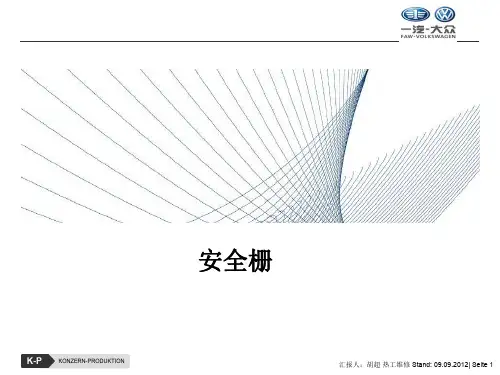

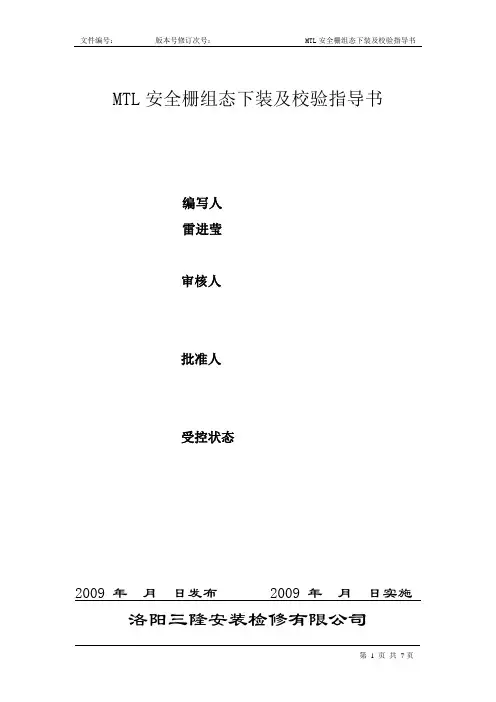
MTL安全栅组态下装及校验指导书编写人雷进莹审核人批准人受控状态2009 年月日发布 2009 年月日实施洛阳三隆安装检修有限公司1 本作业指导书适用范围适用于MTL厂家中需要组态的安全栅的组态下装及校验,主要针对安全栅中的温度变送器,即温度转变成4-20MA。
2 本作业的目的为规范正确的MTL安全栅组态校验的步骤,保证作业过程的安全3 人员资格、人员数量及职责分工3.1操作人须持有三隆公司发给的《安全技术操作合格证》。
操作人须具有一年以上现场仪表施工维护工作经验。
要求作业人员2人,1人作业1人监护。
3.2职责分工3.2.1车间技术组是本作业指导书的主管部门,负责对作业的技术指导、监督、检查。
3.2.2各班组在作业过程中应严格执行操作技术要求及相应安全生产禁令。
4 工器具准备及要求4.1仪表工具2套、笔记本一台、MTL通讯适配器一个,万用表一台。
4.2笔记本内已经安装了MTL安全栅组态程序和适配器驱动程序。
5 着装要求:需正确佩戴安全帽、防护眼镜、劳保着装。
6 作业前检查项目6.1检查接线是否正确。
6.2检查安全栅电源是否正常。
7 技术要求和技术要点7.1在修改下装过程中必须断开连接之后,才能拔下适配器。
7.2所有的密码都是MTL。
8 作业方法和步骤8.1联系工艺规范填写<三隆公司仪表专业日常作业许可证>。
8.2将此安全栅对应的仪表投至手动或校验位。
8.3连接编程器8.3.1将笔记本打开,并把适配器与笔记本连好。
8.3.2将适配器的另外一端与安全栅连接。
8.4安装程序(如果已经安装忽略此步骤)8.4.1 打开光盘,安装组态程序PCS45,比如Pcs45V2p03.exe;8.4.2把适配器与笔记本U口相连,安装驱动程序,此程序在Driver文件夹下;8.5组态8.5.1打开程序“PCS45 Configuration software”。
8.5.2点击connection→establish,与安全栅连接上。
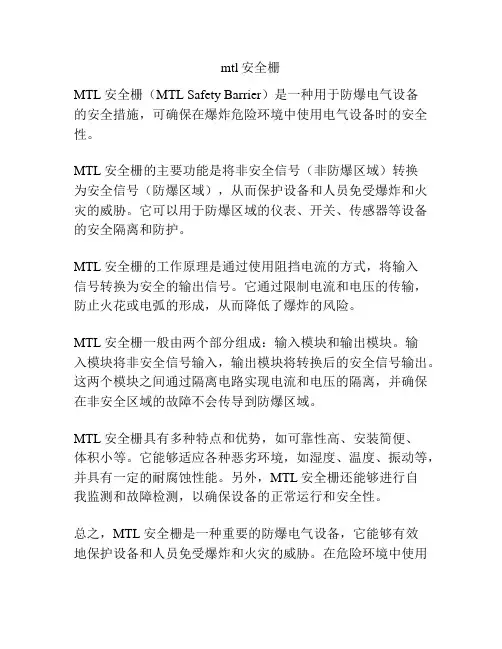
mtl安全栅
MTL安全栅(MTL Safety Barrier)是一种用于防爆电气设备
的安全措施,可确保在爆炸危险环境中使用电气设备时的安全性。
MTL安全栅的主要功能是将非安全信号(非防爆区域)转换
为安全信号(防爆区域),从而保护设备和人员免受爆炸和火灾的威胁。
它可以用于防爆区域的仪表、开关、传感器等设备的安全隔离和防护。
MTL安全栅的工作原理是通过使用阻挡电流的方式,将输入
信号转换为安全的输出信号。
它通过限制电流和电压的传输,防止火花或电弧的形成,从而降低了爆炸的风险。
MTL安全栅一般由两个部分组成:输入模块和输出模块。
输
入模块将非安全信号输入,输出模块将转换后的安全信号输出。
这两个模块之间通过隔离电路实现电流和电压的隔离,并确保在非安全区域的故障不会传导到防爆区域。
MTL安全栅具有多种特点和优势,如可靠性高、安装简便、
体积小等。
它能够适应各种恶劣环境,如湿度、温度、振动等,并具有一定的耐腐蚀性能。
另外,MTL安全栅还能够进行自
我监测和故障检测,以确保设备的正常运行和安全性。
总之,MTL安全栅是一种重要的防爆电气设备,它能够有效
地保护设备和人员免受爆炸和火灾的威胁。
在危险环境中使用
MTL安全栅可以提高工作安全性和生产效率,为工业生产提供保障。
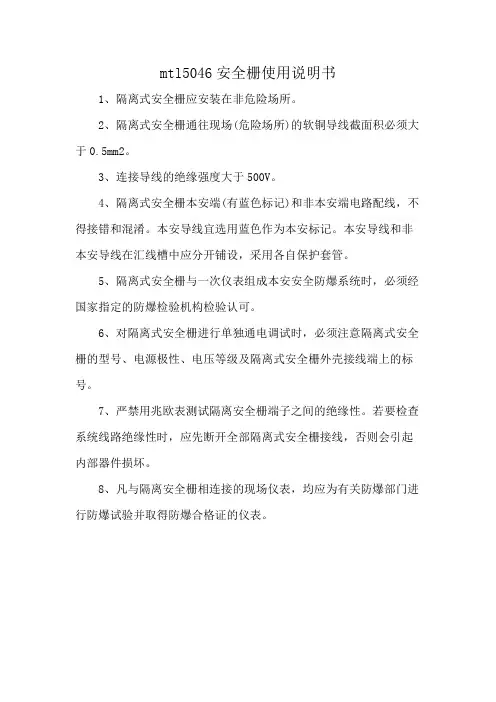
mtl5046安全栅使用说明书
1、隔离式安全栅应安装在非危险场所。
2、隔离式安全栅通往现场(危险场所)的软铜导线截面积必须大于0.5mm2。
3、连接导线的绝缘强度大于500V。
4、隔离式安全栅本安端(有蓝色标记)和非本安端电路配线,不得接错和混淆。
本安导线宜选用蓝色作为本安标记。
本安导线和非本安导线在汇线槽中应分开铺设,采用各自保护套管。
5、隔离式安全栅与一次仪表组成本安安全防爆系统时,必须经国家指定的防爆检验机构检验认可。
6、对隔离式安全栅进行单独通电调试时,必须注意隔离式安全栅的型号、电源极性、电压等级及隔离式安全栅外壳接线端上的标号。
7、严禁用兆欧表测试隔离安全栅端子之间的绝缘性。
若要检查系统线路绝缘性时,应先断开全部隔离式安全栅接线,否则会引起内部器件损坏。
8、凡与隔离安全栅相连接的现场仪表,均应为有关防爆部门进行防爆试验并取得防爆合格证的仪表。

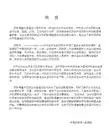
品牌:MTLMTL是一家英国知名公司,成立于25年前,它的本质安全栅和隔离栅成为工业标准已有多年。
该公司在工业过程控制,特别是本安领域中一直处于国际领先地位。
MTL产品在质量、可靠性和安全性方面已经成为工业标准,并获得世界上许多权威机构的认证.MTL公司主要生产齐纳栅、隔离栅、多路转换器、显示器和过程I/O,并同DCS公司和系统集成商有紧密的合作,为石油、石化等工厂提供防爆产品。
MTL公司同时也生产防雷击抗浪涌保护器。
在中国,MTL产品已广泛应用于化工及石油化工、水处理、冶金、制药、电力、水泥、纸浆和造纸、公用事业自动化等领域。
MTL700系列实际是一种“工业规格”,产品注意了固定安装和接地排列。
其运用范围包括超电压保护和子系统电源超高保护。
单通道和双通道供用户任意选择MTL702+/705+/706+/707+/707P+/708+/710+/710-/710ACMTL710P+/710P-/715+/715-/715P+/722+/722-/722P+MTL728+/728-/728AC/728P+/729P+/751AC/755AC 等MTL4000系列第三代隔离接口单元为本安电路集成在大/中型过程控制系统装置提供了一个新的思路。
由于该系列产品结构特别小巧。
因此,具有安装密度高的特点,每个组件是借助于由多通路连接器制成的安全区连接件插件在系统地板上的,这是一种既可简化工程又可降低安装维修费用的方法MTL4013/4014/4015/4016/4017/4021/4023/4024/4025MTL4031/4032/4041/4042/4043/4044/4045/4046/4047MTL4053/4061/4073/4081/4215/4216/4220 等MTL5000系列是MTL最新推出的本安隔离栅,使系统布置和安装更为简便,5000系列提供所有通用功能,因此,安装设计简单易行。
MTL5000系列夹紧式安装方法可将其快速装于DIN导轨上,完全是一种工业标准安装系统,安全区和危险区接线采用简单的插入式接线块,电源插头有多种形式,因此,接线快速,减少接线错误,安全使用,排列整齐。

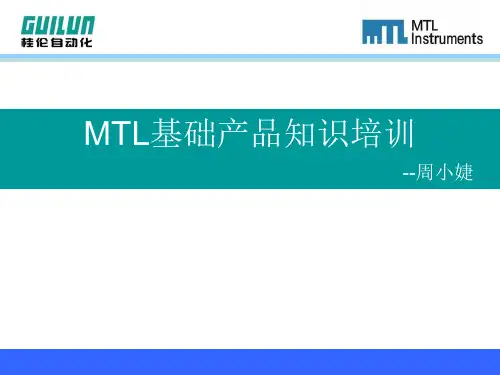
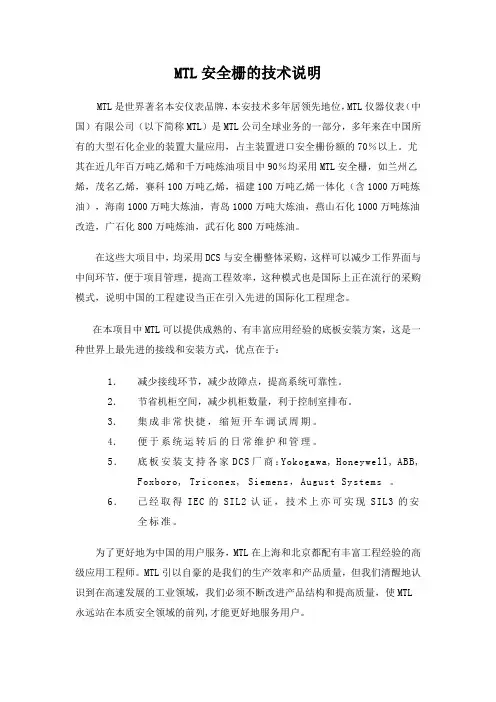
MTL安全栅的技术说明MTL是世界著名本安仪表品牌,本安技术多年居领先地位,MTL仪器仪表(中国)有限公司(以下简称MTL)是MTL公司全球业务的一部分,多年来在中国所有的大型石化企业的装置大量应用,占主装置进口安全栅份额的70%以上。
尤其在近几年百万吨乙烯和千万吨炼油项目中90%均采用MTL安全栅,如兰州乙烯,茂名乙烯,赛科100万吨乙烯,福建100万吨乙烯一体化(含1000万吨炼油),海南1000万吨大炼油,青岛1000万吨大炼油,燕山石化1000万吨炼油改造,广石化800万吨炼油,武石化800万吨炼油。
在这些大项目中,均采用DCS与安全栅整体采购,这样可以减少工作界面与中间环节,便于项目管理,提高工程效率,这种模式也是国际上正在流行的采购模式,说明中国的工程建设当正在引入先进的国际化工程理念。
在本项目中MTL可以提供成熟的、有丰富应用经验的底板安装方案,这是一种世界上最先进的接线和安装方式,优点在于:1.减少接线环节,减少故障点,提高系统可靠性。
2.节省机柜空间,减少机柜数量,利于控制室排布。
3.集成非常快捷,缩短开车调试周期。
4.便于系统运转后的日常维护和管理。
5.底板安装支持各家DCS厂商:Yokogawa, Honeywell, ABB, Foxboro, Triconex, Siemens,August Systems 。
6.已经取得IEC的SIL2认证,技术上亦可实现SIL3的安全标准。
为了更好地为中国的用户服务,MTL在上海和北京都配有丰富工程经验的高级应用工程师。
MTL引以自豪的是我们的生产效率和产品质量,但我们清醒地认识到在高速发展的工业领域,我们必须不断改进产品结构和提高质量,使MTL永远站在本质安全领域的前列,才能更好地服务用户。
P+F安全栅在国内使用故障的装置:1.2004年上海氯碱厂离子膜烧碱装置中P+F的温度变送器隔离栅使用时多次出现故障,更换过两次,给生产造成很大的影响。
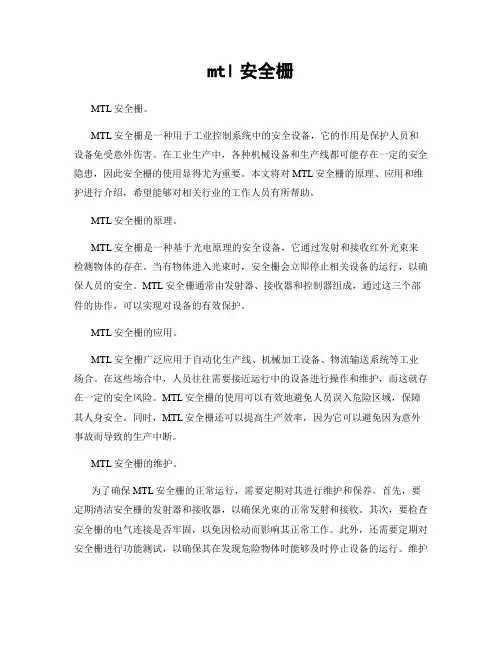
mtl安全栅MTL安全栅。
MTL安全栅是一种用于工业控制系统中的安全设备,它的作用是保护人员和设备免受意外伤害。
在工业生产中,各种机械设备和生产线都可能存在一定的安全隐患,因此安全栅的使用显得尤为重要。
本文将对MTL安全栅的原理、应用和维护进行介绍,希望能够对相关行业的工作人员有所帮助。
MTL安全栅的原理。
MTL安全栅是一种基于光电原理的安全设备,它通过发射和接收红外光束来检测物体的存在。
当有物体进入光束时,安全栅会立即停止相关设备的运行,以确保人员的安全。
MTL安全栅通常由发射器、接收器和控制器组成,通过这三个部件的协作,可以实现对设备的有效保护。
MTL安全栅的应用。
MTL安全栅广泛应用于自动化生产线、机械加工设备、物流输送系统等工业场合。
在这些场合中,人员往往需要接近运行中的设备进行操作和维护,而这就存在一定的安全风险。
MTL安全栅的使用可以有效地避免人员误入危险区域,保障其人身安全。
同时,MTL安全栅还可以提高生产效率,因为它可以避免因为意外事故而导致的生产中断。
MTL安全栅的维护。
为了确保MTL安全栅的正常运行,需要定期对其进行维护和保养。
首先,要定期清洁安全栅的发射器和接收器,以确保光束的正常发射和接收。
其次,要检查安全栅的电气连接是否牢固,以免因松动而影响其正常工作。
此外,还需要定期对安全栅进行功能测试,以确保其在发现危险物体时能够及时停止设备的运行。
维护人员应当具备相关的专业知识和技能,以确保对MTL安全栅的维护工作能够得到有效的执行。
总结。
MTL安全栅作为一种重要的安全设备,对于工业生产中的安全保障起着不可替代的作用。
通过本文的介绍,相信读者对MTL安全栅的原理、应用和维护有了更深入的了解。
在今后的工作中,希望相关行业的工作人员能够加强对MTL安全栅的重视,做好相关的维护和管理工作,确保生产过程中的安全和稳定。
同时,也希望相关厂家能够不断改进和完善MTL安全栅的性能,为工业生产提供更加可靠的安全保障。
MTL5500系列隔离栅1、导轨安装,方便紧凑。
2、采用集成电路和表面封装技术,提高了安全栅的精度,采用新型隔离技术,其功耗比同类型其它产品更低。
3、安全区和危险区接线采用插入式接线块,接线方便,并可方便检查信号。
4、类型齐全,可满足各种信号类型,且带负载能力大。
5、厚度只有16mm,可密集安装,比同类产品节省更多的空间。
6、无本安接地要求,允许危险区电路浮空或任一点接地。
7、可连接0区、IIC、T4-T6经合适认证的设备。
8、所有安全栅均带有电源指示灯,便于检查工作状态。
9、为将供电的风险降到最低,可采用单点供电,也可以采用分组方式,但必须为环路供电。
10、当现场不能提供2V DC电源时,可用MTL5991电源模块,每个模块至少可为16个安全栅供电,当只有少量安全栅时,可用MPA5500适配器提供电源。
11、安装灵活,可根据要求分组并可随意增减。
12、不同种类的安全栅有不同颜色的标记,可以方便使用。
13、能适应较宽的温度范围:-20 –60 度,湿度范围:0 -95%,供电范围:20 –35V DC。
14、电磁兼容性符合EMC EN650 081-2/EN050 682-2标准。
15、原产地:英国开关量输入:MTL5501-SR 1ch DI failsafe solid-state output + LFD alarm MTL5510 4ch DI solid-state outputMTL5510B 4ch DI multifunction solid-state outputMTL5511 1ch DI relay outputMTL5513 2ch DI solid-state outputMTL5514 1ch DI relay output + LFD alarmMTL5516C 2ch DI with changeover relay outputMTL5517 2ch DI relay output + LFD alarm开关量输出:MTL5521 loop powered solenoid driver,IICMTL5522 loop powered solenoid driver,IIBMTL5523 solenoid driver with LFDMTL5524 switch operated solenoid driverMTL5525 switch operated solenoid driver low power MTL5526 2ch switch operated relay脉冲量MTL5532 pulse isolator, digital or analogue output 振动信号:MTL5531 2 wire &3 wire vibration probes, 1chMTL5533 2 wire &3 wire vibration probes, 2ch模拟量输入:MTL5541 1ch 2/3 smart Tx repeaterMTL5541S 1ch 2/3 smart Tx repeater, current sinkMTL5541A 1ch 2/3 smart Tx repeater, passive inputMTL5541AS 1ch 2/3 smart Tx repeater, passive input, current sink MTL5544 2ch 2/3 smart Tx repeaterMTL5544S 2ch 2/3 smart Tx repeater, current sinkMTL5544A 2ch 2/3 smart Tx repeater, passive inputMTL5544AS 2ch 2/3 smart Tx repeater, passive input, current sink MTL5544D 1 in 2 out, 4-20mA, 2/3 smart Tx repeater模拟量输出:MTL5546 1ch 4-20mA smart isolating driver + LFD MTL5546Y 1ch 4-20mA smart isolating driver + oc LFD MTL5549 2ch 4-20mA smart isolating driver + LFD MTL5549Y 2ch 4-20mA smart isolating driver + oc LFD 温度输入:MTL5575 1ch TC/RTD temperature converterMTL5576T 2ch TC temperature converterMTL5576R 2ch RTD temperature converter其它:MTL5599 Dummy isolator1、四通道2、危险区信号:开关/接近开关3、安全区信号:固态继电器4、输出电压:7 –9VDC5、安全区和危险区之间隔离电压为250V AC6、供电:20-35V DC7、功耗:0.96W1、单通道2、危险区信号:开关/接近开关3、安全区信号:继电器干接点带LFD指示灯4、当开关量信号带电阻时可实现线路故障检测功能。
mtl 安全栅MTL安全栅。
MTL安全栅是一种用于工业自动化控制系统的重要安全设备,它能够有效地保护人员和设备免受意外事故的伤害。
本文将介绍MTL安全栅的工作原理、应用范围以及安装和维护方法。
工作原理。
MTL安全栅采用先进的光电技术,能够实时监测并识别物体的位置和运动状态。
当检测到危险物体靠近或穿过安全栅时,系统会立即发出警报并停止相关设备的运行,以确保人员和设备的安全。
同时,MTL安全栅还具有高灵敏度和快速响应的特点,能够在毫秒级内做出反应,有效地避免事故的发生。
应用范围。
MTL安全栅广泛应用于各类自动化生产线、机械加工设备、物流输送系统等领域。
它可以有效地防止人员误入危险区域,防止设备的意外启动,保护生产作业的安全和稳定进行。
同时,MTL安全栅还可以与PLC、DCS等控制系统无缝集成,实现全面的安全监控和控制。
安装和维护。
在安装MTL安全栅时,需要确保其位置和覆盖范围能够有效地覆盖危险区域,并且不会受到外部干扰。
同时,还需要根据实际情况合理设置安全栅的参数和触发逻辑,以确保其能够准确可靠地工作。
在日常维护中,需要定期对MTL安全栅进行检查和测试,确保其性能和响应速度符合要求。
同时,还需要及时清洁和保养安全栅的光电传感器和控制器,以确保其长期稳定可靠地运行。
结语。
MTL安全栅作为工业自动化控制系统中的重要安全设备,具有重要的应用价值和发展前景。
通过本文的介绍,相信大家对MTL安全栅的工作原理、应用范围以及安装和维护方法有了更深入的了解。
在今后的工程实践中,希望大家能够充分发挥MTL安全栅的作用,确保工业生产的安全和稳定进行。
同时,也希望大家能够加强对MTL安全栅的学习和研究,不断推动其技术水平和应用效果的提升,为工业安全和自动化控制做出更大的贡献。
介绍INA5500 MTL5500系列安全指令(ATEX)手册INM5500 MTL5500系列说明书手册MTL4500-5500-ACC 外壳及配件数据表MTL4500-5500-CS 常用规格数据表MTL4500-5500-DS MTL4500-5500系列数据集数据表2。
数字输入MTL5501-SR 1路DI故障安全固态输出+ LFD报警数据表MTL5510 4路DI固态输出中数据表MTL5510B 4路DI多功能固态输出数据表MTL5511 1路DI中继输出数据表MTL5513 双声道DI固态输出数据表MTL5514 1路DI继电器输出+ LFD报警数据表MTL5516C 转换继电器输出双声道DI 数据表MTL5517 双声道DI继电器输出+ LFD报警数据表3。
数字输出MTL5521 回路供电的电磁驱动,IIC 数据表MTL5522 回路供电的电磁驱动,IIB 数据表MTL5523 电磁驱动器LFD 数据表MTL5523V 驱动器与电压控制电磁阀/报警数据表MTL5524 开关操作的螺线管驱动器数据表MTL5525 回路供电的电磁驱动器的低功耗数据表MTL5526 双声道开关操作继电器数据表4。
模拟输入MTL5541 1路2/3线制变送器中继数据表MTL5541A 1路发射机直放站,无源输入数据表MTL5541AS 1路发射机直放站,无源输入,吸入电流数据表MTL5541S 1路2/3线制变送器中继器,吸入电流数据表MTL5544 2CH 2/3线制变送器中继器数据表MTL5544A 双声道发射中继器,被动输入数据表MTL5544AS 双声道发射中继器,被动输入,电流下沉数据表MTL5544D 1路2/3线制变送器中继器,双输出数据表MTL5544S 2CH 2/3线制变送器中继器,吸入电流数据表5。
模拟输出MTL5546 1路4-20mA的智能隔离驱动+ LFD 数据表MTL5546Y 1路4-20mA的智能隔离驱动+ OC LFD 数据表MTL5549 2CH 4-20mA的智能隔离驱动+ LFD 数据表MTL5549Y 2ch的4-20mA的智能隔离驱动+ OC LFD 数据表6。
MTL合作伙伴:滨州新大新机电科技有限公司Part Number FunctionsMTL4501-SR 1ch DI failsafe solid-state output + LFD alarm MTL45104ch DI solid-state outputMTL4510B 4ch DI multifunction solid-state output MTL45111ch DI relay output MTL45132ch DI solid-state output MTL45141ch DI relay output + LFD alarm MTL45162ch DI relay outputMTL4516C 2ch DI with changeover relay output MTL45172ch DI relay output + LFD alarmGENERALMTL4500I/O MODULESby applicationMTL4501-SR FAILSAFE SWITCH/PROXIMITY DETECTOR INTERFACEwith LFDWith the MTL4501-SR, a fail–safe switch/proximity detector located in the hazardous area can control an isolated fail–safe electronic output. The MTL4501–SR units provide line fault detection alarm contacts. The MTL4501–SR is for use with approved fail–safe sensors.SPECIFICATIONSee also common specificationNumber of channelsOneLocation of switchesZone 0, IIC, T6 hazardous areaDiv. 1, Group A hazardous locationLocation of proximity detectorZone 0, IIC, T4–6, hazardous locationDiv 1, Group A, hazardous locationVoltage applied to sensor8.6V dc max from 1kΩInput/output characteristicsInput value in sensor circuits Fail–safeoutputOperation LFD con-tacts2.9mA < Is <3.9mA ON Normal CLOSED Is < 1.9mA & Is > 5.1mA OFF Normal CLOSED Is < 50µA OFF Broken line OPEN Rs < 100ΩOFF Shorted line OPEN Note: Is = sensor currentFail-safe electronic outputOutput on: 24V nominalOutput off: 0V dc, max < 5V dcLoad: 750Ω to 10kΩMaximum on-state current: 25mA (at 750Ω)Short-circuit current: 30mALine fault detection (LFD)LFD relay output: contacts open when line fault detectedSwitch characteristics: 35V ac/dc, 1ALED indicatorsYellow: one provided for output status, ON when fail-safeoutput is energisedGreen: one provided for power indicationRed: one provided for LFD, flashing when line fault is detected Power requirements, Vs@ Supply voltage750Ω load typ. load20V dc100mA70mA24V dc90mA60mA35V dc65mA45mAPower dissipation within unit@ Supply voltage750Ω load typ. load20V dc1232mW1160mW24V dc1392mW1200mW35V dc1507mW1335mWSafety descriptionUo = ±9.7V, Io = 30mA, Po = 0.07W, Ci = 0nF, Li = 0mHUm = 253VNote: switch-type sensors must be fitted with resistors as shownINTERFACEfour-channel, digital inputThe MTL4510 enables four solid-state outputs in the safe area to be controlled by up to four switches or proximity detectors located in a hazardous area. Each pair of output transistors shares a common ter-minal and can switch +ve or –ve polarity signals. A range of module configurations is available (see Table 1) through the use of selector switches. When proximity detector modes are selected, LFD is enabl ed and the output switches to OFF if a line fault is detected.SPECIFICATIONSee also common specificationNumber of channels4, configured by switches Location of switchesZone 0, IIC, T6 hazardous area Div 1, Group A hazardous location Location of proximity detectorsZone 0, IIC, T4-6 hazardous area if suitably certified Div 1, Group A, hazardous location Hazardous-area inputsInputs conforming to BS EN60947–5–6:2001 standards for proximity detectors (NAMUR)Voltage applied to sensor7 to 9V dc from 1k Ω ±10%Input/output characteristicsNormal phaseOutputs closed if input > 2.1mA (< 2k Ω in input circuit) Outputs open if input < 1.2mA (> 10k Ω in input circuit)Hysteresis: 200µA (650Ω) nominalLine fault detection (LFD) (when selected)User-selectable via switches on the side of the unit. Open-circuit alarm on if Iin < 50µA Open-circuit alarm off if Iin > 250µA Short-circuit alarm on if Rin < 100ΩShort-circuit alarm off if Rin > 360ΩNote: Resistors must be fitted when using the LFD facility with a contact input500Ω to 1k Ω in series with switch 20k Ω to 25k Ω in parallel with switchSafe-area outputsFloating solid-state outputs compatible with logic circuits Operating frequency: dc to 500Hz Max. off-state voltage: ± 35V Max. off-state leakage current: ± 50µA Max. on-state resistance: 65ΩMax. on-state current: ± 50mA LED indicatorsGreen: power indicationYellow: four: indicates output activeRed: indicates line fault + faulty channel’s yellow LED flashes Maximum current consumption40mA at 24V (with all output channels energised)Power dissipation within unit0.96W at 24VSafety description (each channel)V o =10.5V I o =14mA P o =37mW U m = 253V rms or dcSee Instruction Manual INM4500 for further mode information.INTERFACEfour-channel, multi-function, digital inputThe MTL4510B enables four solid-state outputs in the safe area to be controlled by up to four switches or proximity detectors located in a hazardous area. Each pair of output transistors shares a com-mon terminal and can switch +ve or –ve polarity signals. A range of module configurations is available (see Table 1) through the use of selector switches. These include start/stop operations and pulse output modes.SPECIFICATIONSee also common specificationNumber of channels4, configured by switchesLocation of switchesZone 0, IIC, T6 hazardous areaDiv 1, Group A hazardous locationLocation of proximity detectorsZone 0, IIC, T4-6 hazardous area if suitably certifiedDiv 1, Group A, hazardous locationHazardous-area inputsInputs conforming to BS EN60947–5–6:2001 standards forproximity detectors (NAMUR)Voltage applied to sensor7 to 9V dc from 1kΩ ±10%Input/output characteristicsNormal phaseOutputs closed if input > 2.1mA (< 2kΩ in input circuit)Outputs open if input < 1.2mA (> 10kΩ in input circuit)Hysteresis: 200µA (650Ω) nominalLine fault detection (LFD) (when selected)User-selectable via switches on the side of the unit.Open-circuit alarm on if Iin < 50µAOpen-circuit alarm off if Iin > 250µAShort-circuit alarm on if Rin < 100ΩShort-circuit alarm off if Rin > 360ΩNote: Resistors must be fitted when using the LFD facility with a contactinput500Ω to 1kΩ in series with switch20kΩ to 25kΩ in parallel with switchSafe-area outputsFloating solid-state outputs compatible with logic circuitsOperating frequency: dc to 500HzMax. off-state voltage: ± 35VMax. off-state leakage current: ± 50µAMax. on-state resistance: 65ΩMax. on-state current: ± 50mALED indicatorsGreen: power indicationYellow: four: indicates output activeRed: LFD indication + faulty channel’s yellow LED flashes Maximum current consumption40mA at 24V (with all output channels energised)Power dissipation within unit0.96 W at 24VSafety description (each channel)Vo =10.5V Io=14mA Po=37mW Um= 253V rms or dcSee Instruction Manual INM4500 for further mode information.MTL4511 SWITCH/ PROXIMITY DETECTOR INTERFACEsingle channel, with line fault detectionThe MTL4511 enables a safe-area load to be controlled by a switch or proximity detector located in a hazardous-area. When selected, open or short circuit conditions in the field wiring are detected by the line-fault-detect (LFD) facility and also indicated on the top of the module. Phase reversal for the channel is selected by a switch on the side of the module and output is provided by changeover relay contacts.SPECIFICATIONSee also common specificationNumber of channelsOneLocation of switchesZone 0, IIC, T6 hazardous areaDiv. 1, Group A hazardous locationLocation of proximity detectorZone 0, IIC, T4–6 hazardous area if suitably certifiedDiv. 1, Group A hazardous locationHazardous-area inputsInputs conforming to BS EN60947–5–6:2001 standards forproximity detectors (NAMUR)Voltage applied to sensor7 to 9V dc from 1kΩ ±10%Input/output characteristicsNormal phaseOutputs closed if input > 2.1mA (< 2kΩ in input circuit)Outputs open if input < 1.2mA (> 10kΩ in input circuit)Hysteresis: 200μA (650Ω) nominalLine fault detection (LFD) (when selected)User-selectable via switches on the side of the unit. A line fault is indicated by an LED. The channel output relay is de-energised if an input line fault is detected.Open-circuit alarm on if Iin < 50μAOpen-circuit alarm off if Iin > 250μAShort-circuit alarm on if Rin < 100ΩShort-circuit alarm off if Rin > 360ΩNote: Resistors must be fitted when using the LFD facility with a contactinput500Ω to 1kΩ in series with switch20kΩ to 25kΩ in parallel with switchSafe-area outputSingle pole relay with changeover contactsNote: reactive loads must be adequately suppressedRelay characteristicsResponse time: 10ms maximumContact rating: 10W, 0.5A, 35V dcLED indicatorsGreen: power indicationYellow: channel status, on when output is energisedRed: LFD indication, on when line fault is detected Maximum current consumption30mA at 24VPower dissipation within unit0.72W at 24VSafety description (each channel)Vo=10.5V Io=14mA Po=37mW Um= 253V rms or dcThe MTL4513 enables two solid-state outputs in the safe area to be controlled by two switches or proximity detectors located in the haz-ardous area. The Ch1/Ch2 output transistors share a common termi-nal and can switch +ve or -ve polarity signals. Independent output phase reversal and line fault detection are enabled via switches for each output. LFD indication is provided on the top of the module.SPECIFICATIONSee also common specificationNumber of channelsTwoLocation of switchesZone 0, IIC, T6 hazardous area Div. 1, Group A hazardous location Location of proximity detectorsZone 0, IIC, T4–6 hazardous area if suitably certified Div. 1, Group A hazardous location Hazardous-area inputsInputs conforming to BS EN60947–5–6:2001 standards for proximity detectors (NAMUR)Voltage applied to sensor7 to 9V dc from 1k Ω ±10%Input/output characteristicsNormal phaseOutputs closed if input > 2.1mA (< 2k Ω in input circuit) Outputs open if input < 1.2mA (> 10k Ω in input circuit)Hysteresis: 200µA (650Ω) nominalLine fault detection (LFD) (when selected)User-selectable for each channel via switches on the side of the unit. Line faults are indicated by an LED for each channel. Open-circuit alarm on if Iin < 50µA Open-circuit alarm off if Iin > 250µA Short-circuit alarm on if Rin < 100ΩShort-circuit alarm off if Rin > 360ΩNote: Resistors must be fitted when using the LFD facility with a contact input 500Ω to 1k Ω in series with switch 20k Ω to 25k Ω in parallel with switchPhase reversalIndependent for each channel, user-selectable Safe-area outputsFloating solid-state outputs compatible with logic circuits Operating frequency: dc to 1kHz Max. off-state voltage: ± 35V Max. off-state leakage current: ± 50µA Max. on-state resistance: 65ΩMax. on-state current: ± 50mAMTL4513 SWITCH/PROXIMITY DETECTOR INTERFACEtwo-channel, with line fault detection and phase reversal*Signal plug HAZ1-3 is required for access to this function LED indicatorsGreen: power indicationYellow: two: channel status, on when outputs are on Red: two: LFD indication, on when line fault detected Maximum current consumption30mA at 24VPower dissipation within unit0.9W typical at 24V with 10mA loads-1.2W max. with 50mA loadsSafety description (each channel)V o =10.5V I o =14mA P o =37mW U m = 253V rms or dcMTL4514 SWITCH/PROXIMITY DETECTOR INTERFACEsingle channel with line fault detection and phase reversalThe MTL4514 enables a safe–area load to be controlled, through a relay, by a proximity detector or switch located in a hazardous area. Line faults are signalled through a separate relay and indicated on the top of the module. Switches are provided to select phase reversal and to enable the line fault detection.SPECIFICATIONSee also common specificationNumber of channelsOneLocation of switchZone 0, IIC, T6 hazardous area Div.1, Group A, hazardous location Location of proximity detectorZone 0, IIC, T4–6 if suitably certified Div.1, Group A, hazardous location Hazardous–area inputsInputs conforming to BS EN60947–5–6:2001 standards for proximity detectors (NAMUR)Voltage applied to sensor7 to 9V dc from 1k Ω ±10%Input/output characteristicsNormal phaseOutputs closed if input > 2.1mA (< 2k Ω in input circuit) Outputs open if input < 1.2mA (> 10k Ω in input circuit)Hysteresis: 200µA (650Ω) nominalLine fault detection (LFD) (when selected)User-selectable via switches on the side of the unit. Line faults are indicated by an LED. Line fault relay is energised and chan-nel output relay de-energised if input line-fault detected Open-circuit alarm on if I in < 50µA Open-circuit alarm off if I in > 250µA Short-circuit alarm on if R in < 100ΩShort-circuit alarm off if R in > 360ΩNote: Resistors must be fitted when using the LFD facility with a contact input 500Ω to 1k Ωin series with switch 20k Ω to 25k Ω in parallel with switchSafe-area outputChannel: Single pole relay with changeover contacts LFD: Single pole relay with changeover contactsNote: reactive loads must be adequately suppressedRelay characteristics Response time: 10ms maximum Contact rating:10W, 0.5A, 35V dc*Signal plug HAZ1-3 is required for access to this function LED indicatorsGreen: power indicationYellow: channel status, on when output circuit is closed Red: LFD indication, on when line fault is detected Maximum current consumption35mA at 24V dcPower dissipation within unit0.72W at 24V Safety descriptionV o =10.5V I o =14mA P o =37mW U m = 253V rms or dcMTL4516 SWITCH/PROXIMITY DETECTOR INTERFACEtwo-channel, with line fault detectionThe MTL4516 enables two safe-area loads to be controlled by a switch or proximity detector located in a hazardous-area. When se-lected, open or short circuit conditions in the field wiring are detected by the line-fault-detect (LFD) facility and also indicated on the top of the module. Phase reversal for each channel is selected by a switch on the side of the module and output is provided by relay contacts.SPECIFICATIONSee also common specificationNumber of channelsTwoLocation of switchesZone 0, IIC, T6 hazardous area Div. 1, Group A hazardous location Location of proximity detectorZone 0, IIC, T4–6 hazardous area if suitably certified Div. 1, Group A hazardous location Hazardous-area inputsInputs conforming to BS EN60947–5–6:2001 standards for proximity detectors (NAMUR)Voltage applied to sensor7 to 9V dc from 1k Ω ±10%Input/output characteristicsNormal phaseOutputs closed if input > 2.1mA (< 2k Ω in input circuit) Outputs open if input < 1.2mA (> 10k Ω in input circuit)Hysteresis: 200µA (650Ω) nominalLine fault detection (LFD) (when selected)User-selectable via switches on the side of the unit. Line faults are indicated by an LED for each channel. The channel output relay is de-energised if an input line fault is detected.Open-circuit alarm on if I in < 50µA Open-circuit alarm off if I in > 250µA Short-circuit alarm on if R in < 100ΩShort-circuit alarm off if R in > 360ΩNote: Resistors must be fitted when using the LFD facility with a contact input 500Ω to 1k Ω in series with switch 20k Ω to 25k Ω in parallel with switchSafe-area outputTwo single-pole relays with normally-open contactsNote: reactive loads must be adequately suppressedRelay characteristicsResponse time: 10ms maximum Contact rating:10W, 0.5A, 35V dc*Signal plug HAZ1-3 is required for access to this function LED indicatorsGreen: power indicationYellow: two: channel status, on when output is energised Red: two: LFD indication, on when line fault detected Maximum current consumption35mA at 24VPower dissipation within unit0.84W at 24VSafety description (each channel)V o =10.5V I o =14mA P o =37mW U m = 253V rms or dcMTL4516C SWITCH/PROXIMITY DETECTOR INTERFACEtwo-channel, with line fault detectionThe MTL4516C enables two safe-area loads to be controlled by a switch or proximity detector located in a hazardous-area. When se-lected, open or short circuit conditions in the field wiring are detected by the line-fault-detect (LFD) facility and also indicated on the top of the module. Phase reversal for each channel is selected by a switch on the side of the module and output is provided by changeover relay contacts.SPECIFICATIONSee also common specificationNumber of channelsTwoLocation of switchesZone 0, IIC, T6 hazardous area Div. 1, Group A hazardous location Location of proximity detectorZone 0, IIC, T4–6 hazardous area if suitably certified Div. 1, Group A hazardous location Hazardous-area inputsInputs conforming to BS EN60947–5–6:2001 standards for proximity detectors (NAMUR)Voltage applied to sensor7 to 9V dc from 1k Ω ±10%Input/output characteristicsNormal phaseOutputs closed if input > 2.1mA (< 2k Ω in input circuit) Outputs open if input < 1.2mA (> 10k Ω in input circuit)Hysteresis: 200µA (650Ω) nominalLine fault detection (LFD) (when selected)User-selectable via switches on the side of the unit. Line faults are indicated by an LED for each channel. The channel output relay is de-energised if an input line fault is detected.Open-circuit alarm on if I in < 50µA Open-circuit alarm off if I in > 250µA Short-circuit alarm on if R in < 100ΩShort-circuit alarm off if R in > 360ΩNote: Resistors must be fitted when using the LFD facility with a contact input 500Ω to 1k Ω in series with switch 20k Ω to 25k Ω in parallel with switchSafe-area outputTwo single-pole relays with changeover contactsNote: reactive loads must be adequately suppressedRelay characteristicsResponse time: 10ms maximum Contact rating:10W, 0.5A, 35V dc*Signal plug HAZ1-3 is required for access to this function LED indicatorsGreen: power indicationYellow: two: channel status, on when output is energised Red: two: LFD indication, on when line fault detected Maximum current consumption35mA at 24VPower dissipation within unit0.84W at 24VSafety description (each channel)V o =10.5V I o =14mA P o =37mW U m = 253V rms or dcMTL4517 SWITCH/PROXIMITY DETECTOR INTERFACEtwo-channel with line fault detection and phase reversalThe MTL4517 enables two safe-area loads to be controlled, through a relay, by proximity detectors or switches located in a hazardous area. Line faults are signalled through a separate relay and indicated on the top of the module. Switches are provided to select phase re-versal and to enable the line fault detection.SPECIFICATIONSee also common specificationNumber of channelsTwoLocation of switchZone 0, IIC, T6 hazardous area Div.1, Group A, hazardous location Location of proximity detectorZone 0, IIC, T4–6 if suitably certified Div.1, Group A, hazardous location Hazardous-area inputsInputs conforming to BS EN60947–5–6:2001 standards for proximity detectors (NAMUR)Voltage applied to sensor7 to 9V dc from 1k Ω ±10%Input/output characteristicsNormal phaseOutputs closed if input > 2.1mA (< 2k Ω in input circuit) Outputs open if input < 1.2mA (> 10k Ω in input circuit)Hysteresis: 200µA (650Ω) nominalLine fault detection (LFD) (when selected)User selectable by switches on the side of the module. LIne faults are indicated by the LED for each channel.Line fault relay is energised and channel output relay de-ener-gised if input line-fault detected Open-circuit alarm on if I in < 50µA Open-circuit alarm off if I in > 250µA Short-circuit alarm on if R in < 100ΩShort-circuit alarm off if R in > 360ΩNote: Resistors must be fitted when using the LFD facility with a contact input 500Ω to 1k Ω in series with switch 20k Ω to 25k Ω in parallel with switchSafe-area outputChannel: Two single-pole relays with normally open contacts LFD: Single pole relay with changeover contactsNote: reactive loads must be adequately suppressedRelay characteristics Response time: 10ms maximum Contact rating:10W, 0.5A, 35V dc*Signal plug HAZ1-3 is required for access to this function LED indicatorsGreen: power indicationYellow: two: channel status, on when output is energised Red: two: LFD indication, on when line fault detected Maximum current consumption35mA at 24VPower dissipation within unit0.84W at 24VSafety description (each channel)V o =10.5V I o =14mA P o =37mW U m = 253V rms or dcMTL4521 SOLENOID/ALARM DRIVERloop-powered, IICThe MTL4521 is a loop-powered module which enables a device lo-cated in the hazardous area to be controlled from the safe area. The MTL4521 can drive a certified intrinsically safe low-power load, as well as non-energy-storing simple apparatus such as an LED.SPECIFICATIONSee also common specificationNumber of channelsOneLocation of loadZone 0, IIC, T4–-6 hazardous area if suitably certified Div. 1, Group A hazardous locationMinimum output voltage Equivalent output circuitInput voltage20 to 35V dcHazardous-area outputMinimum output voltage: 12.8V at 48mA Maximum output voltage: 24V from 180ΩCurrent limit: 48mA Output ripple< 0.5% of maximum output, peak to peak Response timeOutput within 10% of final value within 100ms48Output current (mA)Output voltage (V)21.412.8*Signal plug HAZ1-3 is required for access to this function LED indicatorYellow: output status, on when output circuit is active Maximum current consumption90mA at 24VPower dissipation within unit1.4W at 24V Safety descriptionV o =25V I o =147mA P o =919mW U m = 253V rms or dcWith the MTL4523 interface, an on/off device in a hazardous area can be controlled by a voltage signal in the safe area. It is suitable for driving loads such as solenoids. Line fault detection (LFD), which oper-ates irrespective of the output state, is signalled by a safe-area solid-state switch which de-energises MTL4523, or energises MTL4523R, if a field line is open or short–circuited. Earth fault detection can be provided by connecting an MTL4220 earth leakage detector to terminal 3.SPECIFICATIONSee also common specificationNumber of channelsOneLocation of loadZone 0, IIC, T4–6 hazardous area if suitably certified Div. 1, Group A, hazardous locationMinimum output voltage Equivalent output circuitHazardous-area outputMinimum output voltage: 12.8V at 48mA Maximum output voltage: 24V from 180ΩCurrent limit: 48mA Output ripple< 0.5% of maximum output, peak to peak Control inputSuitable for switch contacts, an open collector transistor or logic driveOutput turns on if input switch closed, transistor on or < 1.4V applied across terminals 10 & 11Output turns off if input switch open, transistor off or > 4.5V applied across terminals 10 & 11Response timeOutput within 10% of final value within 100ms Line fault detection (LFD)Open or short circuit in field cabling de-energises solid state line fault signal. (MTL4523R transistor is energised when line fault is detected)LFD transistor is switched on (off MTL4523R), provided that the field circuit impedance is > 55Ω and < 6k5Ω. Line fault signal characteristicsMaximum off-state voltage: 35VMaximum off-state leakage current: 10µA Maximum on-state voltage drop: 2V Maximum on-state current: 50mANote: LFD signal is Zener-diode protected against inductive loadsMTL4523/4523RSOLENOID/ALARM DRIVERwith line fault detection, IICLED indicatorsGreen: power indicationYellow: output status, on when output circuit is active Red: LFD indication, on when line fault is detected Maximum current consumption100mA at 24V dcPower dissipation within unit1.2W with typical solenoid valve, output on2.0W worst case Safety descriptionV o =25V I o =147mA P o =919mW U m = 253V rms or dc48Output current (mA)Output voltage (V)21.412.8EPS4523/4523R-5*Signal plug HAZ1-3 is required for access to this functionWith the MTL4523L interface, an on/off device in a hazardous area can be controlled by a voltage signal in the safe area. It is suitable for driving loads such as solenoids. Line fault detection (LFD), which op-erates when the output is energised, is signalled by a safe-area solid-state switch which energises if a field line is open or short-circuited. Earth fault detection can be provided by connecting an MTL4220 earth leakage detector to terminal 3.SPECIFICATIONSee also common specificationNumber of channelsOneLocation of loadZone 0, IIC, T4–6 hazardous area if suitably certified Div. 1, Group A, hazardous locationMinimum output voltage Equivalent output circuitInput voltage20 to 35V dcHazardous-area outputMinimum output voltage: 12.8V at 48mA Maximum output voltage: 24V from 180ΩCurrent limit: 48mA Output ripple< 0.5% of maximum output, peak to peak Response timeOutput within 10% of final value within 100ms Line fault detection (LFD)Open or short circuit in field cabling energises solid state line fault signalLFD transistor is switched on, provided that the field circuit impedance is > 55Ω and < 6k5Ω. Line fault signal characteristicsMaximum off-state voltage: 35VMaximum off-state leakage current: 10µA Maximum on-state voltage drop: 2V Maximum on-state current: 50mANote: LFD signal is Zener-diode protected against inductive loadsALARM DRIVERloop-powered with line fault detection, IIC*Signal plug HAZ1-3 is required for access to this functionLED indicatorsYellow: output status, on when output circuit is active Red: LFD indication, on when line fault is detected Maximum current consumption100mA at 24V dcPower dissipation within unit1.2W with typical solenoid valve, output on Safety descriptionV o =25V I o =147mA P o =919mW U m = 253V rms or dcALARM DRIVERswitch operated with override, IICThe MTL4524 enables an on/off device in a hazardous area to be controlled by a volt-free contact or logic signal in the safe area. It can drive loads such as solenoids, alarms, LEDs and other low power devices that are certified as intrinsically safe or are classified as non-energy storing simple apparatus. By connecting a second safe-area switch or logic signal, the output can be disabled to permit, for exam-ple, a safety system to override a control signal.SPECIFICATIONSee also common specificationNumber of channelsOneLocation of loadZone 0, IIC, T4–6 hazardous area if suitably certified Div.1, Group A, hazardous locationMinimum output voltage Equivalent output circuitHazardous-area outputMinimum output voltage: 12.8V at 48mA Maximum output voltage: 24V from 180ΩCurrent limit: 48mA Output ripple< 0.5% of maximum output, peak-to-peak Control inputSuitable for switch contacts, an open collector transistor or logic drive0 = input switch closed, transistor on or <1.4V applied across terminals 10 & 111 = input switch open, transistor off or >4.5V applied across terminals 10 & 11Override inputAn open collector transistor or a switch connected across ter-minals 8 and 9 can be used to turn the output off whatever the state of the control input0 = transistor on or switch closed 1 = transistor off or switch open Control and override inputsControl inputOverride inputOutput state00off 01on 10off 11offResponse timeOutput within 10% of final value within100ms48Output current (mA)Output voltage (V)21.412.8*Signal plug HAZ1-3 is required for access to this function LED indicatorsGreen: power indicationYellow: output status, on when output circuit is active Maximum current consumption100mA at 24V dcPower dissipation within unit1.3W with typical solenoid valve, output on 1.9W worst case Safety descriptionV o =25V I o =147mA P o =919mW U m = 253V rms or dc。